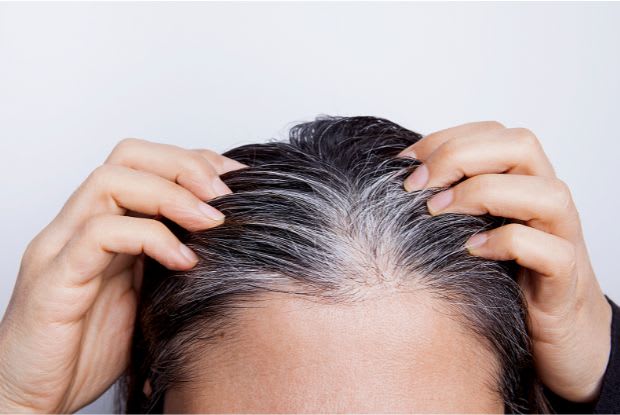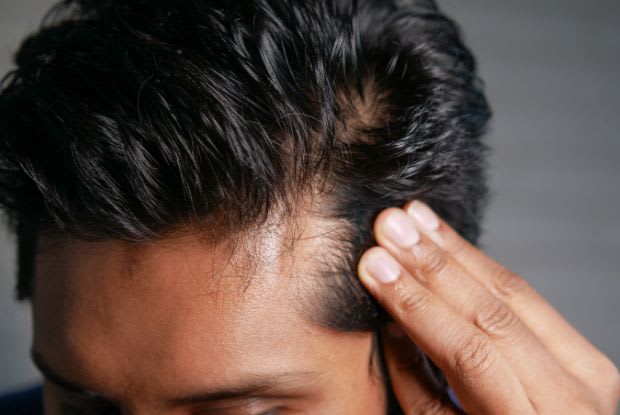Oral Minoxidil: A Promising Solution for Patterned Hair Loss
Oral Minoxidil: A Promising Solution for Patterned Hair Loss
Table of Contents
I. Oral Minoxidil for Hair Loss
IV. Is Oral Minoxidil Right for You?
On an average day, most people shed 50 to 100 strands of hair as part of the natural hair growth cycle. However, noticing clumps of hair falling out or a visibly thinning hairline could indicate the onset of hair loss. 1 The most common type of hair loss is androgenetic alopecia, also known as pattern baldness, which can affect up to half of men over 50 and women after menopause. 2
In recent years, doctors have increasingly prescribed oral minoxidil for hair loss in both men and women. But are oral minoxidil results just as good as the topical version? And is it safe to use?
In this article, we’ll explore oral minoxidil for hair loss, how it compares to topical minoxidil, and what kind of oral minoxidil results men and women with pattern hair loss can expect.
Oral Minoxidil for Hair Loss
Originally developed as a medication for managing hypertension, oral minoxidil took researchers by surprise with an unexpected side effect: significant hair growth. This discovery paved the way for the creation of topical minoxidil, which has since gained FDA approval for combating hair loss in both men and women. 2
While the oral form of minoxidil remains FDA-approved solely for high blood pressure treatment, there has been a notable shift in recent years. More and more doctors are prescribing oral minoxidil off-label to address hair loss concerns among their patients. 2
This is because, despite the effectiveness of topical minoxidil in treating hair loss, many individuals struggle with compliance due to various reasons:
- Unwanted changes in hair texture post-application
- Scalp irritation
- The formulation’s scent
- Allergic reaction to minoxidil
- The requirement for twice daily application 2
For those facing these challenges, oral minoxidil for hair loss may be a more convenient alternative. Typically, patients begin to witness oral minoxidil results within three months of starting treatment. 2
Oral Minoxidil vs Topical Minoxidil
Research has found that low-dose oral minoxidil can be an effective treatment for both female-pattern hair loss (FPHL) and male-pattern hair loss (MPHL). In clinical trials comparing oral minoxidil to topical minoxidil, oral minoxidil performed just as well as the standard 5% topical solution at regrowing hair. 2
Furthermore, oral minoxidil for hair loss offers several advantages over the topical formulation:
- For minoxidil to work, it needs to be converted to its active form, minoxidil sulfate, within the body. Research shows that oral minoxidil leads to higher levels of minoxidil sulfate in hair follicles compared to topical minoxidil.
- Oral minoxidil is better tolerated than the topical solution for some people. Topical minoxidil can cause unwanted side effects like itching, changes in hair texture, and allergic reactions in certain individuals.
- Oral minoxidil is more convenient since it only requires swallowing a pill versus applying a topical solution twice daily.
- Topical minoxidil can make hair appear greasy or distort hair color, whereas oral minoxidil avoids these issues.
- Oral minoxidil also allows for the use of cosmetic hair fibers to provide an immediate thickening effect. 2
So, should you choose topical minoxidil or oral minoxidil for hair loss? The choice comes down to personal preference. Those who dislike applying topical solutions and want the most convenient option may prefer an oral pill. However, patients with minimal hair loss who don’t mind using a topical treatment may find that approach simpler. Either way, both topical and oral minoxidil results are equally significant.
Female-Pattern Hair Loss

According to studies, over 50% of women experience noticeable hair thinning after menopause. The most common culprit is female pattern hair loss (FPHL), which is caused by a genetic condition that makes hair follicles shrink over time and produce thinner, finer strands. 2
FPHL manifests differently than male-pattern baldness (MPHL):
- Hair loss typically starts at the center part and spreads outward, creating a Christmas tree-like pattern
- The hairline remains intact
- Complete baldness is rare for women
- If hair loss is due to increased male sex hormones called androgens, the hair on the head becomes wispier and finer, while facial hair becomes darker and coarser 3
Oral Minoxidil for Hair Loss in Women
Studies evaluating oral minoxidil for hair loss have shown promising results in women. In fact, 61 to 86% of women experienced positive oral minoxidil results, such as increased hair growth and hair thickness. 2
Researchers found that taking low doses of oral minoxidil, between 0.25 mg and 1.25 mg per day, can improve FPHL while limiting side effects. 2
Male-Pattern Hair Loss

Male pattern hair loss (MPHL) affects up to half of all men by middle age. 2 This gradual hair loss typically begins above the temples, slowly progressing across the top and center of the scalp. 4
To track the stages of male pattern baldness, doctors use the Norwood scale. Developed in 1975 by Dr. James Norwood, this classification system divides hair loss into seven stages based on how much and where thinning has occurred: 4
- Stage 1: Little to no hairline recession.
- Stage 2: Triangular patterns of decreased hair density appear at the temples.
- Stage 3: The hairline recedes into an “M” or a “U” shape, and the temples show more pronounced thinning. Most men first notice their hair loss at this stage.
- Stage 4: The receding hairline and balding patches expand, with only a narrow band of hair left crossing the top of the head.
- Stage 5: The connecting band becomes sparse and thin.
- Stage 6: The receding hairline and balding crown merge, leaving just a narrow or completely absent strip of hair over the top.
- Stage 7: Only a horseshoe-shaped ring of hair remains around the sides and back of the head. The top of the scalp is completely bald. 4
Oral Minoxidil for Hair Loss in Men
Researchers have found that men generally need higher oral minoxidil doses than women to see results. While a 0.25 mg dose effectively treats hair loss in women, studies show that the same low dose only led to 40 to 60% improvement in men, with minimal impact on hair density and thickness. 2
Studies show that oral minoxidil for hair loss in men is effective when taken at doses ranging from 2.5 mg to 5 mg per day. However, a daily dose of 5 mg appears to yield the best outcomes for men with mild to moderate hair loss. 2
When starting oral minoxidil for hair loss, doctors usually recommend beginning with a low dose of 1.25 mg daily. After taking this initial dosage for 6 months, the dose can be increased to 2.5 to 5 mg daily if the oral minoxidil results are not noticeable. This gradual increase in dosage limits potential side effects. 2
Is Oral Minoxidil Right for You?
So, should you use topical or oral minoxidil for hair loss?
Oral minoxidil is only FDA-approved for treating high blood pressure. So, if you want to try it for hair growth, you’ll need to talk to your doctor first. They can look at your medical history and symptoms and decide if oral minoxidil for hair loss is right for you.
This step is important because oral minoxidil can cause side effects in some people. For example:
- Patients with severely high blood pressure shouldn't take oral minoxidil due to the risk of pericardial effusion.
- Pregnant women should avoid oral minoxidil due to the heightened possibility of excessive hair growth in newborns.
- Elderly patients with specific health conditions such as heart issues or renal failure should steer clear of oral minoxidil. 2
However, studies show that some people can really benefit from oral minoxidil for hair loss. These include young adults with moderate pattern baldness. Those who don’t see results from topical minoxidil or can’t use it properly are also good candidates. 2
The bottom line? If you’re not getting results from topical minoxidil, talk to your doctor. They can work with you to determine if oral minoxidil for hair loss is a good option for you.
Conclusion
The rising trend of doctors prescribing oral minoxidil for hair loss is backed by compelling research. Studies have shown that oral minoxidil results are comparable to topical minoxidil. Moreover, oral minoxidil may be easier to use than a topical formulation. This can increase patient adherence, which makes the medication more effective.
However, while this alternative hair loss treatment holds promise, it’s essential to have a thorough conversation with your healthcare provider before deciding. Not everyone is a suitable candidate for oral minoxidil. In fact, specific populations may be at risk of experiencing serious side effects. By partnering with your doctor, you can make sure you take oral minoxidil safely.
References
- Harvard Health Hair loss
- Ramírez-Marín, H. A., & Tosti, A. Role of oral minoxidil in patterned hair loss
- Penn Medicine Female Pattern Baldness
- Gupta, M., & Mysore, V. Classifications of patterned hair loss: A Review
